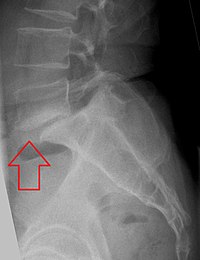
Photo from wikipedia
BACKGROUND It remains unclear if minimally invasive transforaminal lumbar interbody fusion (MI-TLIF) is comparable to traditional, open TLIF because of the limitations of the prior small-sample-size, single-center studies reporting comparative… Click to show full abstract
BACKGROUND It remains unclear if minimally invasive transforaminal lumbar interbody fusion (MI-TLIF) is comparable to traditional, open TLIF because of the limitations of the prior small-sample-size, single-center studies reporting comparative effectiveness. OBJECTIVE To compare MI-TLIF to traditional, open TLIF for grade 1 degenerative lumbar spondylolisthesis in the largest study to date by sample size. METHODS We utilized the prospective Quality Outcomes Database registry and queried patients with grade 1 degenerative lumbar spondylolisthesis who underwent single-segment surgery with MI- or open TLIF methods. Outcomes were compared 24 mo postoperatively. RESULTS A total of 297 patients were included: 72 (24.2%) MI-TLIF and 225 (75.8%) open TLIF. MI-TLIF surgeries had lower mean body mass indexes (29.5 ± 5.1 vs 31.3 ± 7.0, P = .0497) and more worker's compensation cases (11.1% vs 1.3%, P < .001) but were otherwise similar. MI-TLIF had less blood loss (108.8 ± 85.6 vs 299.6 ± 242.2 mL, P < .001), longer operations (228.2 ± 111.5 vs 189.6 ± 66.5 min, P < .001), and a higher return-to-work (RTW) rate (100% vs 80%, P = .02). Both cohorts improved significantly from baseline for 24-mo Oswestry Disability Index (ODI), Numeric Rating Scale back pain (NRS-BP), NRS leg pain (NRS-LP), and Euro-Qol-5 dimension (EQ-5D) (P > .001). In multivariable adjusted analyses, MI-TLIF was associated with lower ODI (β = -4.7; 95% CI = -9.3 to -0.04; P = .048), higher EQ-5D (β = 0.06; 95% CI = 0.01-0.11; P = .02), and higher satisfaction (odds ratio for North American Spine Society [NASS] 1/2 = 3.9; 95% CI = 1.4-14.3; P = .02). Though trends favoring MI-TLIF were evident for NRS-BP (P = .06), NRS-LP (P = .07), and reoperation rate (P = .13), these results did not reach statistical significance. CONCLUSION For single-level grade 1 degenerative lumbar spondylolisthesis, MI-TLIF was associated with less disability, higher quality of life, and higher patient satisfaction compared with traditional, open TLIF. MI-TLIF was associated with higher rates of RTW, less blood loss, but longer operative times. Though we utilized multivariable adjusted analyses, these findings may be susceptible to selection bias.
Journal Title: Neurosurgery
Year Published: 2020
Link to full text (if available)
Share on Social Media: Sign Up to like & get
recommendations!